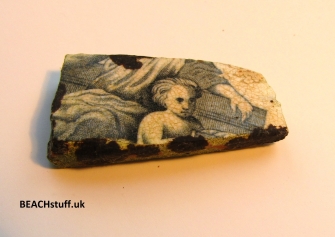

Beach Pottery
aka Sea Pottery
Pieces of pottery, some rounded by the action of the sea, can often be found on the beach. While many are plain white, others can carry tantalising clues to what they once were and to their age.
Pottery can find itself on the beach having been left by picnickers; discarded or dropped from working boats, or perhaps even lost as cargo.

Pottery pieces may be rounded by the action of the sea (above), or left sharp by relatively recent breakages (below). Unlike beach glass, the level of rounding and smoothing doesn't matter to most collectors. An interesting or attractive pottery piece retains its charm even if it has sharp edges.

Paddle steamers
These are my absolute favourite pottery finds. All four pieces were found one winter in Ilfracombe Harbour which once had daily visits from a number of paddlesteamers, part of the P & A Cambell fleet in place from the mid ninteenth century. These pieces must have come from the branded crockery they had on board for their passengers.

I have found several pieces of two or three different styles of logo which presumably reflect different eras. However, I haven't found a whole logo of any style. The closest I have got is these four pieces which do join together to form a whole - using a bit of computer jiggery pockery - below.


Willow Pattern
One of the most commonly found recognisable patterns is the willow pattern. These depictions of ancient rural China in distinctive blue and while became popular in the 18th century. It is remarkable how one, relatively obscure (if you live outside rural China) gained and retained such popularity around the world. In America it is known as Blue Willow, just to confuse us.

Half of a ceramic marble
Before glass marbles came ceramic marbles! This one could be 18th century or it could be a modern copy.


Crazing
Crazing on a piece of pottery - the cracking of the upper glaze layer - can be an indication of age.
Pottery makers' marks
Pottery can hold the maker's stamp on its base. A bit of detective work on the internet can help find the location and era of the maker.


'Wedg'
Wedgwood began in 1759 when Josiah Wedgwood began selling pottery in Burslem, Staffordshire. The company is still going today. So this fragment could either be from 1759 and worth an absolute fortune, or made and broken only yesterday. I know which one my money's on...

'Pountney's Bristol, England. Reinforced vitrite'
Pountney's another old pottery, beginning trading in around 1815, closed in 1969.
The company also used the name Bristol Pottery or Bristol Potteries with a green B to mark their work - below.

Some pieces of pottery feel like amazing miniature pieces of art. What a plate this must have been!



Thick utilitarian pieces - as above - are often from sewerage pipes and drains.
While this fragment of a marmalade pot handily gives a date - 1882 - there are lots of modern copies of these types of pots currently on sale. Given the good condition of this piece, I suspect it is far more likely to be twenty-first century than nineteenth century.

There is a slight clue here as to what this fragment may have come from...










